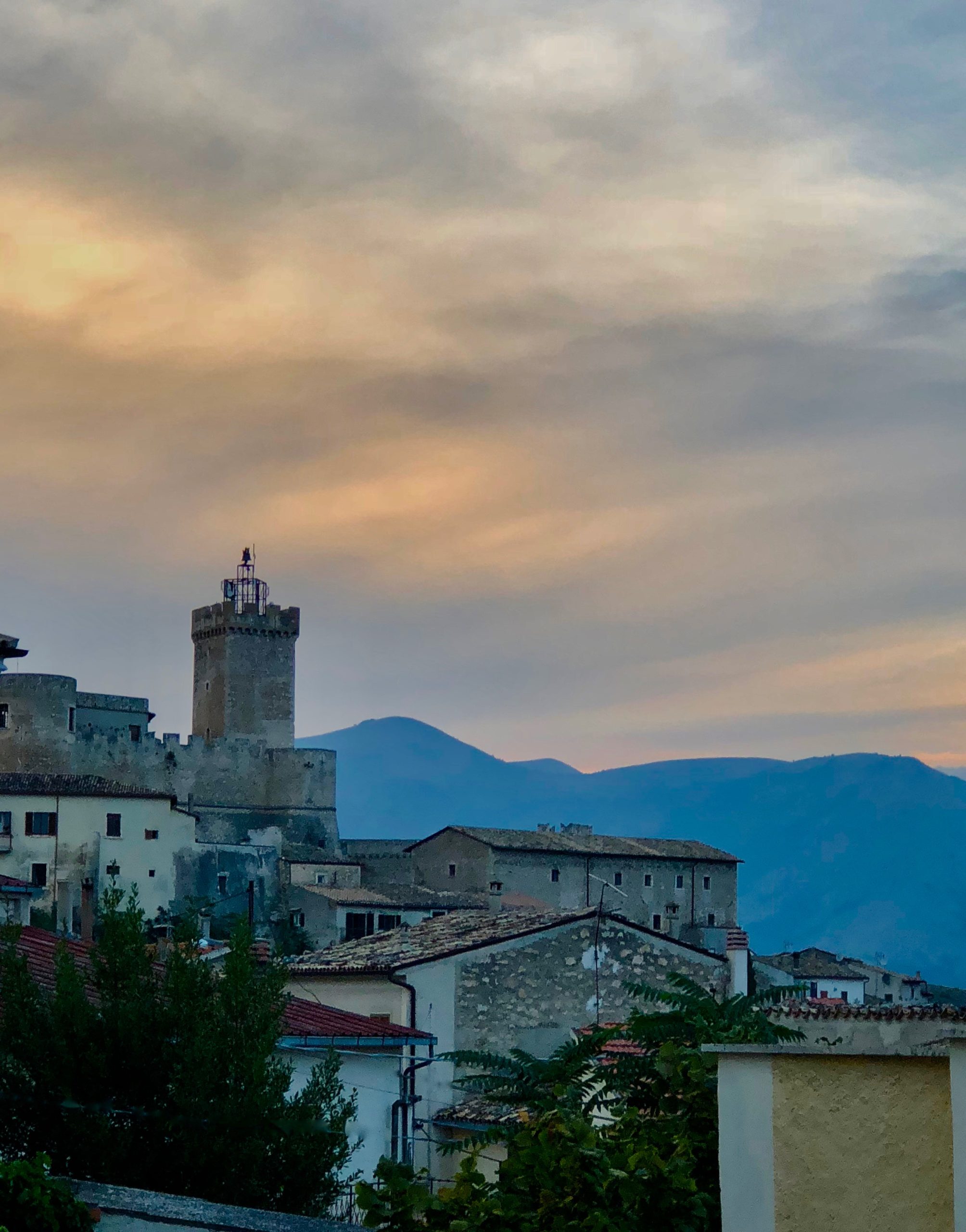Abruzzo and The Trabocchi Coast
Abruzzo is not to be trifled with. It is indeed mighty (“forte e gentile”) as its majestic mountains looming above the gentle valleys testify. Their cold grey crevices still hold, I imagine, the blood of many battles, but their peaks are crowned with a headdress of ice that softens their physiognomy so that they yet are capable of stilling your mind when you look at them.

This was the first impression I got as I began my visit through this wondrous land. And it is an impression that still lies with me.
After a delicious pause of ten days with close friends, I headed east and south towards the coast. It had been years that Frank and Julie, good friends that also hail from Abruzzo, had been enticing me with tales and remembrances of their beloved seaside home.
If one friend introduced me to her mighty land, the other laid before me the gentle sweep of the ocean as it breaks lovingly, caressing the Abruzzese coastline.


We arrived at Rocca San Giovanni by meandering through a landscape characterized by the presence of centuries-old olive trees and the bright colors of gorse (ginestra) that define the entire coast.

Getting there at midday is a privilege for those lucky enough to see it. I stood still to admire the transparent sea, the brilliant sun that magically sprinkled the sea with glistening reflections, and the trabocco.

I had heard from our friends about these thingamajigs, and now there in front of me, being rocked gently by the ocean winds was a strange stilt house with antennas springing out of it, and layers of netting hanging over its sides. It looked like a big prehistoric insect coming out of the sea ready to eat us. Gabriele D’Annunzio, the famous Italian poet who was born in Abruzzo, described them as ‘ragni colossali’ (colossal spiders).

The Coast of the Trabocchi is a stretch of Adriatic coastline, which begins around Francavilla Al Mare in Abruzzo and reaches down through Termoli in Molise and as far south as the Gargano promontory. It is characterized by the presence of the “trabocchi”, old fishing machines on stilts which can be seen creeping, crab-like, into the waters and which, since past centuries, have provided fishermen with a safe way of fishing, even in the most adverse of sea conditions.
That day the coast took us along State Road 16 Adriatica, from Francavilla al Mare, passing through Ortona, San Vito Chietino and reaching Rocca San Giovanni, one of the prettiest villages in Italy, where life flows slowly and where the overflow on the beach reminds us of the patient work of the sea that at dawn overflows onto the nets the treasures of the sea.

The earliest documented existence of Trabocchi dates back to the 18th century, but it probably goes back to Phoenician times. “What is sure is that they were invented by farmers and not by fishermen…. ‘La fame spinge il lupo fuori dalla tana!’(hunger forces a wolf out of his den,) so our ancestors understood that when the crop was poor, they could also harvest the ‘fruits of the sea’ and came up with a system that was safe and easy for them.”https://www.italymagazine.com/featured-story/la-costa-dei-trabocchi-discovering-abruzzos-fishing-tradition
The trabocco, is a platform, usually built using beams of oak, spruce and Aleppo pine. It is connected to the coast by a bridge, and is characterized by long arms called antenne. These antenne stretch out, suspended some meters above the sea and support a narrow-meshed net called trabocchetto (trap). The fishermen retrieve the fish from the bottom of the net while it is still lying in the water using a long sieve like a scoop.

Before World War II, 4 to 5 families could live on the catch from a trabocco. Now these structures have simply become a cultural symbol of the area with no economic function save as a tourist attraction. https://www.italymagazine.com/featured-story/la-costa-dei-trabocchi-discovering-abruzzos-fishing-tradition Many however, have become restaurants that welcome curious guests or simply those who are pescetarians and love a good meal of freshly caught fish.


It was well past midday when we were seated, a group of 11 of us, at a long rustic table, on the Trabocco Pesce Palombo. On the old timber wall at the entrance, pictures of various movie stars and other celebrities proclaimed its already well-established reputation.



A refreshing and salty breeze caught at my nostrils. Looking out to the sea a white bird perched on one of the antennae jutting out from the palafitta we sat on. I couldn’t resist the click of my camera to capture the attentive watch of this bird over the cast nets. The backdrop of a perfect azure sky completed the image I had created in my head of sitting aboard the Jolly Roger, a bird sitting on the bowsprit—the spar extending forward from the vessel’s prow, and Captain Cook ready to give the order to set sail.


The order I heard muffled in the background of my musings was the voice of one of our men telling us to take our seat as the fish was ready to be served. Soon, out came paper cones filled with delicately fried Adriatic anchovies (Cartoccio di Alici), shrimp with broad beans, (Gamberi con Fave), mackerel with cherry tomatoes and olives (Sgombro di pomodorini e olive), Pamlombo fish with saffron and aubergines (Pesce Palombo, zafferano e melanzane); and this was just the antipasto!




The Primi, no less exotic-sounding were a medley of flavours from the sea and colours of of this coastal region. They were bountiful and varied, and kept coming until we pleaded defeat and asked to be spared from the dessert.


A plate of ‘bocconotti’, Abruzzo’s seductive rustic little morsels, with their scalloped buttery shells and a lovely chocolate and nut filling cocooned within, somehow made their way to our table.
We ate abundantly that day, together, at a long table on a “trabocco”, being gently rocked by the rhythmic pulse of the Adriatic. We laughed, and spoke much too loudly; kept repeating the mantra of “what a beautiful place”, and finally, spent and satiated, we toasted with an amaro to friendship.

0



